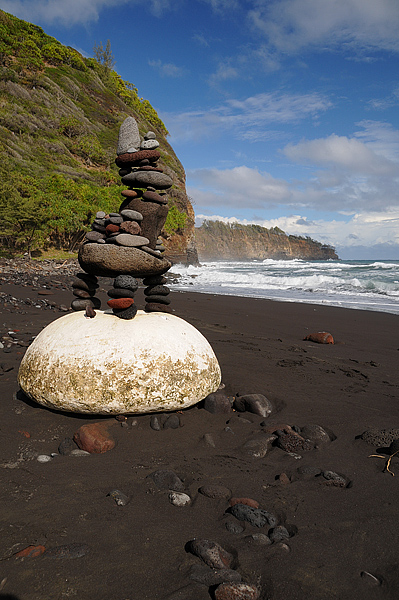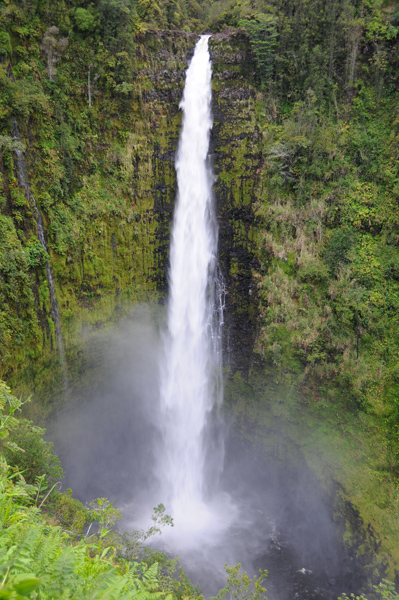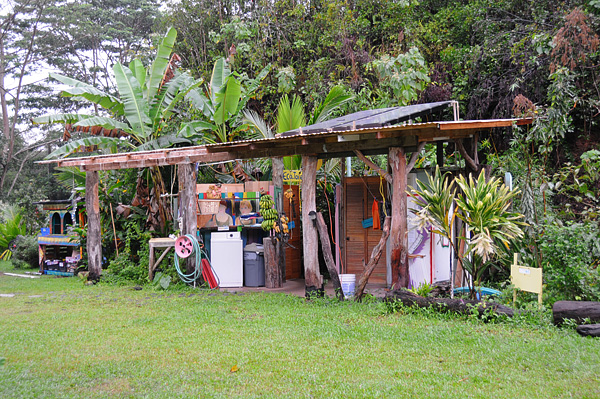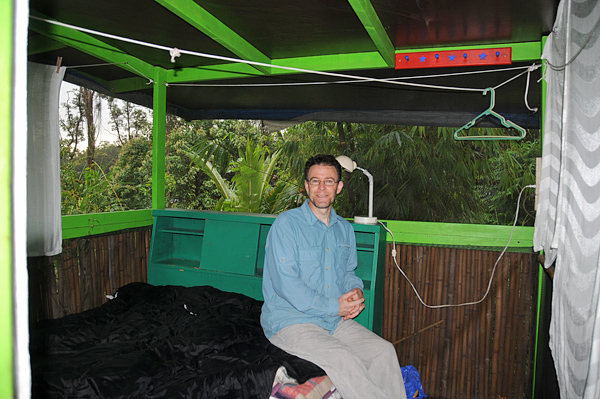The weather improved and we headed out of Waimea to the island’s northernmost communities. Karen gravitated to Kawi’s small farmer’s market, where we bought delicious Filipino sweets and taro sweet buns under a sprawling banyan tree, and I took special note of the shaved ice store further along in Kapa’au to remember for later in the day as we passed through again. After having traveled through more of the massive historic Parker Ranch, we drove all the way to the road’s end above Pololu Valley.
A steep but short hike to the valley bottom opened up new vistas and an even wilder, less developed side of Hawaii’s north shores. Like Waipi’o, Pololu met the Pacific at a black lava crescent beach surrounded by verdant sheer cliff walls. But Pololu was only accessible by hiking trail, and there were no taro farmers in funky shacks to be found anywhere. Instead, Hawaii-adapted trees grew from black sand dunes, and the entire beach was pure black sand with a rocky inland outline against the cliffs.
Surfers relaxed on the rocks above the beach, having come down the same trail that we just hiked. But while we had worn hiking boots, they wore flip flops while carrying a surfboard. In their spare time they watched wave sets, cooked hot dogs over a driftwood fire, and build ornate rock cairns as a creative outlet.
The frothy waves spewed misty clouds into the air, wafting inland and giving the forest trails a diffuse glow in the warm sunlight. Hiking up the other side of the next cliff wall and over to the next valley called Honokane Nui, we were treated to a private viewing of an even remoter valley that spanned from its chasm-forming river and out to large seastacks ringed with the white pounding turbulence of the Pacific.
After returning from the hot hike, that shaved ice stand was definitely remembered: lilikoi flavor with a vanilla ice cream center…
We then retraced miles back through ranch land to Waimea and further onto Honoka’a so we could head southeast along the northeast coast of the island. The road there did not have big tourist attractions or momentous sites, but I really appreciated the beautiful back road exploring opportunities it offered.
The road flowed through views of the ocean to the left and forested hillsides to the right, occasionally passing over impressive jungle-laden gulches bright with flowered trees and deep green flora.
By paying attention to our maps, we were able to detour onto several sections from the old roads of the coast. These were the same roads that existed when a rail line ran down the coast, before the main road was ever built. These roads were special.
They twisted and turned through the communities of old rusted metal-roofed shacks still lived in by the locals. Between homes, long stretches of sugar cane land or, more serenely, overarching tree tunnels of vine-covered tropical forest. Rickety bridges would curve with the road, and all were still very passable even though some had no guardrails anymore and others made loud clattering noises as their bridge deck timber boards visibly bounced up and down on weakened nails. Each bridge brought a new cascading stream or small waterfall; most were worthy of a stop to take a gander. The roads also presented little surprises to visit for a few minutes, such as the great fruit stand owned by a friendly Hawaiian, or a tiny park that only the locals used or probably even knew about.
Off the main road past Honomu Town, Akaka Falls State Park preserved a 420 foot waterfall in its own ground out amphitheater. The walk to the waterfall was like a dense botanical garden, except Mother Nature was the primary landscaper.
The quaintness ended with Hilo, though, which was the east side’s version of Kona. Lots of big box stores, airport, a cruise ship parked out front, and traffic everywhere. So, we passed through that and continued south to Hedonisia in Pahoa.
In the pouring rain (which was the norm for this trip) we approached the lush entrance to Hedonisia, a hippie hostel experience centered around small un-permitted structures and a good vibe. Brightly colored murals filled the sides of the owner’s cabin and “The Barn” communal shared space, both lining the dirt driveway. We were warmly greeted by the onsite manager Lisa – who gave us a night tour with our flashlights and rain gear – and the British-born owner Mojo.
The Barn served as a central area with electricity, lights, Internet connected computer, television with DVDs, shared kitchen, and a large outdoor dirt porch where people were singing to a guitar and rolling their own. The shower had a small roof, but was otherwise completely exposed 180 degrees around to the jungle. The toilet sat beside that, and was similarly open to the outdoors.
Hedonisia was set up so that guests could stay in one of about 10 different variations on accommodations. There was the Bamboo Hut, which was our choice; it was an 8 foot by 8 foot hut with bamboo half walls and screening above that. No insulation, little privacy, and no frills except for the brightly colored paint. The bed was semi-comfy, though the pillows were musty from the occasional rain mist that came onto our bed from side gusts of wind blowing through the always open screen walls.
The setting was beautiful, but the sleep was fitful and meager. Non-native Caribbean coqui frogs had strongly infiltrated that part of the island, and those things were piercingly LOUD (90 decibels). Multiply that by hundreds, surrounding us on all trees in all directions, and it was a cacophony of unrest. Ear plugs only helped when we were so tired that we drifted fitfully in start-stops of sleep. Other than that, Hedonisia had much to recommend it.








Leave A Comment